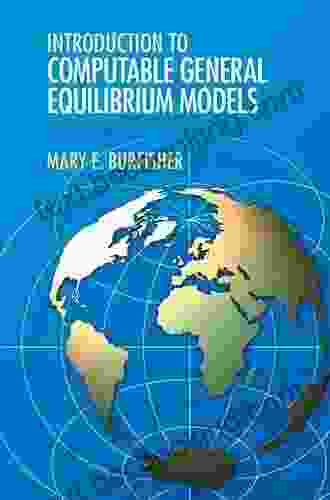Unlocking the Nuances of Computable General Equilibrium Models: A Comprehensive Guide

In the dynamic tapestry of economics, Computable General Equilibrium Models (CGEMs) stand as invaluable tools for understanding the intricate interplay of economic forces. These sophisticated models provide a comprehensive framework for analyzing the effects of economic policies, technological advancements, and environmental changes.
This comprehensive guide delves deep into the world of CGEMs, explaining their fundamentals, methodologies, and far-reaching applications. Whether you're a seasoned economist, a policymaker, or simply curious about the intricacies of economic modeling, this guide will equip you with the knowledge and insights you need to navigate this complex landscape effectively.
5 out of 5
| Language | : | English |
| File size | : | 6559 KB |
| Text-to-Speech | : | Enabled |
| Screen Reader | : | Supported |
| Enhanced typesetting | : | Enabled |
| Word Wise | : | Enabled |
| Print length | : | 408 pages |
What are Computable General Equilibrium Models?
CGEMs are mathematical representations of an entire economy. They incorporate a vast array of economic sectors, from agriculture and manufacturing to services and government. By simulating the interactions between these sectors, CGEMs provide a comprehensive view of how economic policies and external shocks affect the economy as a whole.
Unlike other economic models, CGEMs are "computable," meaning they can be solved using computers. This allows economists to explore a wide range of scenarios and analyze the potential consequences of different policy choices.
Methodologies of CGEMs
CGEMs employ various methodologies to simulate economic behavior. The most common approach is the Social Accounting Matrix (SAM) framework. SAMs provide a snapshot of the economy at a specific point in time, capturing the flows of goods, services, and income between different sectors and agents.
Other methodologies include the Input-Output (I-O) framework and the General Algebraic Modeling System (GAMS). Each methodology has its strengths and limitations, and the choice of methodology depends on the specific research question being addressed.
Applications of CGEMs
CGEMs have a wide range of applications in economic policymaking. They are used to analyze the effects of:
- Trade policies
- Fiscal policies
- Monetary policies
- Climate change policies
- Sustainable development policies
By simulating the potential impacts of these policies, CGEMs provide valuable insights to policymakers in designing effective economic strategies.
Case Studies and Examples
To illustrate the practical applications of CGEMs, let's explore some real-world case studies:
- The World Bank used a CGEM to analyze the potential effects of a free trade agreement between the United States and Colombia. The model predicted that the agreement would lead to increased trade and economic growth in both countries.
- The European Union used a CGEM to assess the economic impact of its carbon pricing政策. The model showed that the policy would reduce greenhouse gas emissions while also having a modest impact on economic growth.
- The United Nations Development Programme used a CGEM to evaluate the potential benefits of investing in sustainable agriculture in developing countries. The model found that such investments could lead to significant improvements in food security and economic resilience.
Advantages and Limitations of CGEMs
Like any modeling tool, CGEMs have their advantages and limitations:
Advantages:
- Comprehensiveness: CGEMs provide a comprehensive view of the entire economy, taking into account the interactions between all sectors and agents.
- Policy analysis: CGEMs allow economists to analyze the potential effects of different economic policies, providing valuable insights to policymakers.
- Scenario testing: CGEMs can be used to simulate a wide range of scenarios, helping economists and policymakers understand how the economy might respond to different shocks or changes.
Limitations:
- Data requirements: CGEMs require a large amount of data to calibrate and solve. This data can be difficult to obtain, especially for developing countries.
- Simplifications: CGEMs are simplifications of the real economy and cannot capture all of its complexities. This can lead to inaccuracies in some cases.
- Computational complexity: Solving CGEMs can be computationally intensive, especially for large models. This can limit the size and scope of the models that can be built.
Computable General Equilibrium Models are powerful tools for understanding the complex interactions within an economy. They provide economists and policymakers with valuable insights into the potential effects of different policies and external shocks.
While CGEMs have their limitations, their advantages far outweigh their drawbacks. By embracing the strengths and addressing the limitations of CGEMs, we can continue to harness their power to inform economic policymaking and promote sustainable economic development.
Whether you're a seasoned economist, a policymaker, or simply curious about the inner workings of economic models, this guide has provided you with the foundation you need to navigate the world of Computable General Equilibrium Models with confidence.
5 out of 5
| Language | : | English |
| File size | : | 6559 KB |
| Text-to-Speech | : | Enabled |
| Screen Reader | : | Supported |
| Enhanced typesetting | : | Enabled |
| Word Wise | : | Enabled |
| Print length | : | 408 pages |
Do you want to contribute by writing guest posts on this blog?
Please contact us and send us a resume of previous articles that you have written.
 Book
Book Novel
Novel Page
Page Chapter
Chapter Text
Text Story
Story Genre
Genre Reader
Reader Library
Library Paperback
Paperback E-book
E-book Magazine
Magazine Newspaper
Newspaper Paragraph
Paragraph Sentence
Sentence Bookmark
Bookmark Shelf
Shelf Glossary
Glossary Bibliography
Bibliography Foreword
Foreword Preface
Preface Synopsis
Synopsis Annotation
Annotation Footnote
Footnote Manuscript
Manuscript Scroll
Scroll Codex
Codex Tome
Tome Bestseller
Bestseller Classics
Classics Library card
Library card Narrative
Narrative Biography
Biography Autobiography
Autobiography Memoir
Memoir Reference
Reference Encyclopedia
Encyclopedia Marie Tillman
Marie Tillman Melanie Cambridge
Melanie Cambridge Rachel Dickinson
Rachel Dickinson Stefan Hollos
Stefan Hollos Mark Weakland
Mark Weakland Mario Glowik
Mario Glowik Rudolf Hoss
Rudolf Hoss Pearl S Buck
Pearl S Buck Matt Rogers
Matt Rogers Mark Taylor
Mark Taylor Stephen Preskill
Stephen Preskill Masih Alinejad
Masih Alinejad Mary Carolyn Waldrep
Mary Carolyn Waldrep Mary Turzillo
Mary Turzillo Peter Owen
Peter Owen Martin Mosebach
Martin Mosebach Salima Ikram
Salima Ikram Mark Graham
Mark Graham Patrick Mansell
Patrick Mansell Massimo Pigliucci
Massimo Pigliucci
Light bulbAdvertise smarter! Our strategic ad space ensures maximum exposure. Reserve your spot today!

 Oliver FosterThe Routledge Atlas of the Arab-Israeli Conflict: An In-Depth Exploration of...
Oliver FosterThe Routledge Atlas of the Arab-Israeli Conflict: An In-Depth Exploration of... Everett BellFollow ·15.2k
Everett BellFollow ·15.2k David MitchellFollow ·12.2k
David MitchellFollow ·12.2k Jim CoxFollow ·4k
Jim CoxFollow ·4k Alex ReedFollow ·13.4k
Alex ReedFollow ·13.4k Louis HayesFollow ·9.7k
Louis HayesFollow ·9.7k Cason CoxFollow ·5.8k
Cason CoxFollow ·5.8k Fernando PessoaFollow ·16.4k
Fernando PessoaFollow ·16.4k Derek CookFollow ·17.2k
Derek CookFollow ·17.2k

 Larry Reed
Larry ReedGwendy's Final Task: A Thrilling Conclusion to a Timeless...
Prepare to be...

 Victor Turner
Victor TurnerHow FDR Defied Polio to Win the Presidency
Franklin D. Roosevelt is...

 Edwin Cox
Edwin CoxWinner RGS BBC Journey of a Lifetime Award: An Inspiring...
In the heart of the world's...

 Griffin Mitchell
Griffin MitchellEverything You Need to Know, You Learned From Mister...
Mister Rogers' Neighborhood was a beloved...

 Beau Carter
Beau CarterSeasons of Terror: A Spine-Tingling Odyssey into the...
In the realm of horror...
5 out of 5
| Language | : | English |
| File size | : | 6559 KB |
| Text-to-Speech | : | Enabled |
| Screen Reader | : | Supported |
| Enhanced typesetting | : | Enabled |
| Word Wise | : | Enabled |
| Print length | : | 408 pages |












